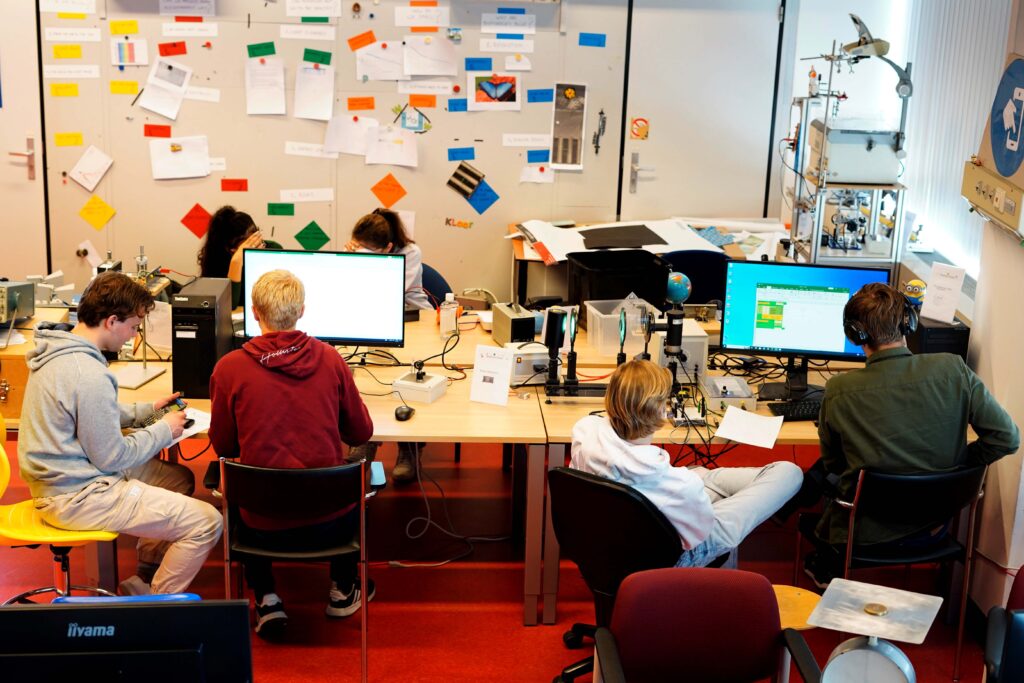Het vaksteunpunt Contact.vwo Leiden verbindt het vwo-onderwijs voor het vak Natuurkunde met de afdelingen Natuur- en Sterrenkunde van de Universiteit Leiden. We bieden activiteiten voor leraren en voor leerlingen. Op de website van de universiteit vind je het actuele aanbod. Het onderwerp quantum krijgt extra aandacht op deze site. We ondersteunen het vak Natuurkunde voor vwo-6 leerlingen met de Quantum Rules! lab & game experience en bieden docenten die het vak NLT geven de module Kansen met Quantum aan. Daarnaast is er een lesmodule Quantum Keuzes ontwikkeld voor de onderbouw.
NLT module Kansen met Quantum
Geef de module Kansen met Quantum over quantumcomputing binnen het vak NLT op jouw school. De module appelleert aan leerlingen met interesse in wiskunde, natuurkunde, informatica / programmeren maar ook hen met interesse in farmacie, recht en ethiek (filosofie). Kijk op de Kansen met Quantum pagina.
Quantum Rules! lab & game experience
Bezoek Quantum Rules! in Leiden met je vwo-6 klas(sen) Natuurkunde. Laat je leerlingen de stof van Quantumwereld letterlijk in de vingers krijgen. Klik op Reserveren voor het boeken van een dagje quantum. Er zijn geen kosten aan verbonden. Voor meer informatie, zie de Quantum Rules! pagina.

English summary
- Quantum Rules! brings the quantum world to pupils and their teachers of the pre-university high-school level. The program started in 2015 as support for the then newly introduced quantum component of the physics curriculum. The physics department supported the development of a set of about fifteen quantum-related experimental set ups, and provided a permanent lab facility.
- In the program a class up to thirty pupils and their teachers are our guests. In the morning the pupils perform one or two practical assignments. During lunch there is an option for a scientific lecture, in which physics or astronomy students tell about their bachelor project. These lectures indicate the steep learning curve of education. Three years after their high-school finals, students can already give a modest contribution to scientific research.
- The program afternoon builds upon the results of the morning program. We developed a game-like setting in which we aim to cross-disseminate the knowledge that is acquired in the morning program. In this way all pupils can get knowledge of all the experiments. In this leisurely setting we project this knowledge to societal issues. The aim of the game is to work together, and of course there is a time constraint. These are essential elements of an escape-room.
Credits
De QuantumRules! lab & game experience is opgezet door Henk Buisman met bijdragen van Bram van Leeuwen, Corjan Meijerink, Marcel Kolenbrander, Tania Moraga-Calderón, Ivana van Leeuwen en anderen.
De ontwikkeling van de Quantum Rules! lab & game experience en de Kansen met Quantum NLT module kwamen tot stand met financiële ondersteuning van o.a. de Nederlandse Natuurkundige Vereniging, de Nationale Wetenschapsagenda, het Quantum Software Consortium en Quantum Delta NL.